Sharif Adams, traditional bowl turner and spoon carver tells the story of the Bowl Gathering, from humble beginnings to a thriving gathering of craft revival.
“Tradition is not the worship of ashes, but the preservation of fire.”
-Gustav Mahler

The author, Sharif, turning a bowl on a lathe. Credit: Fern Leigh Albert
The third Bowl Gathering has come and gone. A week of celebrating wooden bowls, made using simple hand tools and machines from a bygone age. Evenings of song and music, conversation and laughter shared round the fire beneath a harvest moon. But to understand the Bowl Gathering properly we must first travel back in time…
Twelve years ago I met a man who made wooden bowls using an archaic machine; a pole lathe. A pole lathe is a simple device, operated by means of a foot driven treadle, which allows the operator to spin a piece of wood between two centres and shape the wood while it spins using hand tools. At the time he was the only person in this country making bowls this way full time and, as such, the only person who was keeping this traditional craft alive. In fact Robin Wood, the man I am referring to, had brought the craft back from the dead.

Turning a bowl on a traditional pole lathe. Credit: Fern Leigh Albert
For one reason or another Robin wouldn’t teach me when I asked him to, so I joined the Association of Pole Lathe Turners and Green Wood Workers of Great Britain, hoping to meet someone who knew how it was done. People were using pole lathes to turn spindles for chairs and other items like candle sticks and goblets, but nobody seemed to know anything about bowl turning.
I did eventually track down a green woodworker in Essex who knew how it was done. He invited me to his workshop and we spent the day going through the process. I took photos and measurements of his lathe, asked him how he forges his tools and headed home full of enthusiasm. I built a lathe, then built a makeshift forge using bricks, charcoal and an old hair dryer. I made some rudimentary ‘hook tools’ using recycled steel from old car springs. I began turning bowls.

A finished bowl with handles made by Matt Whittaker from Durham. Credit: Fern Leigh Albert
Over the next few years I started to meet a few other pole-lathe turners who were also interested in bowl turning. Once or twice a year I invited them to bring their lathes to the woods, to camp and turn bowls together, and share what we had learned about this little-known craft. Those weekends were deeply inspiring. We all learned so much from each other. There was very little information available on the Internet at the time, and the few people who did know anything were not forthcoming with their hard earned secrets.
Our small gatherings felt very open in contrast. What we knew we shared freely, and this combined sharing served to move us all forward. The seed vision of the future Bowl Gathering festivals had been planted in my mind, but it was only years later that this seed germinated.

Sharing tips and skills is an important part of the gathering. Credit: Fern Leigh Albert
A few years later I was earning my living teaching bowl turning from my home at Steward Community Woodland in Devon. Based on the increasing numbers of people attending my courses I knew that interest in traditional bowl turning was steadily growing. The green woodworking world in general was getting bigger thanks to various social media platforms. American craftsman Jarrod Dahl calls this movement ‘The New Wood Culture’ or ‘The Wood Culture Renaissance’. These phrases describe a way of life which place an emphasis on simple hand tools and a direct connection to trees, woodlands, tradition and community which people from all around the world and all walks of life are feeling drawn to at this present time.
Almost all of our ancestors once lived in ‘wood cultures’. Wood provided all they needed to live on this earth; their homes, hunting tools, boats. The knowledge of how to best use this beautiful material was once fundamental to us as human beings. The ‘New Wood Culture’ is about rediscovering this knowledge, relearning these skills, but in the context of the modern world. It’s about a way of life which believes that less is more. Slowing down. An antidote to our modern, fast paced, disconnected lives dominated by screens, office work and mass production.

Beautiful bowls by Beth Moen from Sweden. Credit: Fern Leigh Albert
By now there were several seriously committed pole lathe bowl turners in this country, some of whom had attended courses with me in the past and had since started running their own courses. I began to daydream about hosting a small festival to celebrate pole lathe bowl turning. Memories of the small gatherings a few of us had years ago returned to me, and I felt it would be great to re-create that shared space of learning with this new tide of enthusiasm and interest in the craft. During a conversation with my friend David Kuegler, he offered his Herefordshire meadow as a venue for the first ever Bowl Gathering. That first event consisted of just twenty or so people. David’s meadow was perfectly situated in Herefordshire, being fairly central for those coming from the north and south of England. But the physical space wouldn’t allow the event to grow any bigger.

Carving ‘kuksa’ – traditional Scandinavian wooden cups. Credit: Fern Leigh Albert
Will St Clair then offered his place as a venue. He had recently taken on a woodland glamping business, Brookhouse Wood, not far from David’s meadow where he runs various green woodworking courses. Brookhouse Wood once belonged to Mike Abbot, who used to teach chair making courses there. All the infrastructure was in place, with a woodland kitchen area, hot showers, compost toilets and beautiful wooden ‘hobbit houses’ and cabins where people could stay if they didn’t want to pitch a tent. There was also a big open meadow on the edge of the woods with level ground where the main event could take place. It was perfect. I felt that my dream had come true when Will stepped up with his offer. My friend Yoav, who had visited me a few times at Steward Wood while attending some of my courses was involved with Brookhouse Woods too. By now Yoav had become an accomplished bowl turner and was running his own courses from Brookhouse Woods. Having Yoav there to help Will with the prep and organisation of the Bowl Gathering was a great additional bonus.

Credit: Fern Leigh Albert
So it was that the second Bowl Gathering took place in 2018. It was a great success. Teachers came not just from the UK but from Sweden, Holland and France. Pre-fest courses on offer covered a wide variety of pole lathe turned vessels, including bowls, cups, boxes and flasks, as well as carved bowls using axes, adazes and gouges and catered for complete beginners through to those at a more advanced level. Shorter sessions during the weekend event were very popular and meant that everybody was able to get involved and learn some new techniques or have their first go at pole lathe bowl turning.
The gathering was small enough that everyone was soon on first name terms; there’s something lovely about that intimacy which gets lost at bigger events. Evenings consisted of a circle round a big fire, with local ales and ciders sold from the back of a horse box. We created our own entertainment with acoustic music and songs which went on late in to the night while the stars shone down on us and the fire burned bright and warm.

Credit: Fern Leigh Albert
This year, 2019, was the third Bowl Gathering. Everyone was in agreement; it was definitely the best so far. Perhaps it’s a combination of the same people meeting up for the third time, that feeling of familiarity with people and place. There were lots of people who were enjoying it all for the first time too. The overall standard of work on display over the weekend is already significantly better than it was just two years ago.

Finished Kuksas carved by Jan Harm Ter Brugge from Holland. Credit: Fern Leigh Albert
When George Lailey died in 1958 the craft of traditional pole-lathe bowl turning died with him. Thirty years later Robin Wood resurrected this lost craft and that single spark has now become a well established fire. It’s heart warming to see the Bowl Gathering establish itself over the last few years as an indicator of just how secure the future of pole-lathe bowl turning has become in such a short space of time. A few years ago this craft was on the Heritage Craft Association’s ‘critically endangered’ list. It is now re-classified as ‘endangered’ and is steadily moving towards ‘currently viable’.
The Bowl Gathering festival is valuable for many reasons to those of us who attend. But it also serves an important role in helping to promote and keep alive this almost lost craft. I’m deeply grateful to my friend David Kuegler for getting the ball rolling initially and to Will St Clair for taking it on long term at Brookhouse Woods. It seems that the future of traditional bowl turning is looking very bright indeed.

Credit: Fern Leigh Albert
Find details of the Bowl Gathering 2020 here.
 About the author
About the author
Sharif Adams teaches a variety of courses mostly focused around all aspects of pole lathe turning. His workshop is an old stone threshing barn on Dartmoor, Devon, but he also teaches and demonstrates at some of the main green woodworking events around the country. For more information on his work and courses, visit his website where you will also find links to a series of YouTube tutorials. You can also find him on Instagram @wooden_way.

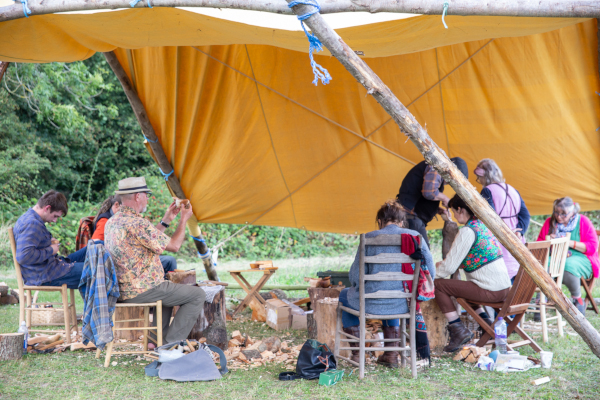
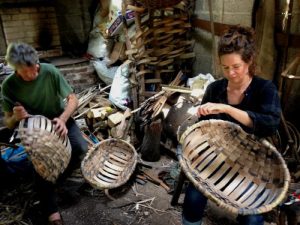
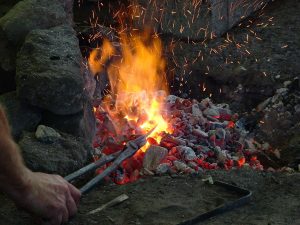
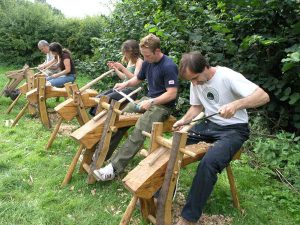
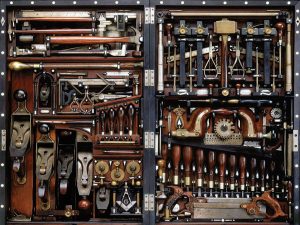
2 Comments
I used to work on a Rudolf Steiner project for adults with learning disabilities. We called it green wood working, rather than lathe turning. Many Steiner projects have a green wood working lathe, which even those with quite severe disabilities can use. It was seen as something theraputic, (being in touch with Nature) rather than something practical, but, of course, it could be useful too. The lathes were built by the support workers themselves, and were very simple affairs. I was delighted to read this article, and to know that such activities do still exist.
Hi Christie, thanks for your comment. Pole lathe turning and green woodwork in general is both therapeutic and practical as you suggest. This is why so many people are being drawn to it these days. Nice to hear of your connection to the Steiner project. I have been involved with the Steiner school near Totnes in the past. They have a dozen lathes which I was called in to renovate. I then stood in for the woodwork teacher while she was on sabbatical. I taught you yes children pole lathe turning over a few months one winter which was a great experience. Wishing you all the best, Sharif.